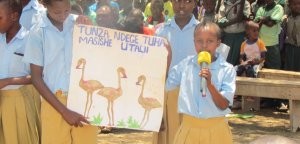
At TBA, we give people the skills and knowledge they need to make a positive impact in tropical conservation. Our training forms the foundation for successful careers with a wide range of organizations, from government agencies, to NGOs.
As a young graduate, Ken Mwathe, crossed the border from his home country Kenya to spend a month exploring the sights, sounds and science of Kibale forest on a TBA field course in Uganda.
That was fourteen years ago, but the experience shaped his future as a conservationist.
Ken went on to gain an MSc in Tropical and International Forestry and also worked for the Kenya Wildlife Service as a research scientist. Like many TBA alumni, as he gained experience, he was glad to share his knowledge by coming back to teach for us on a Specialist Training Course on Measuring Ecosystem Services in 2013 .
Today, he is a Policy and Advocacy Manager for Birdlife Africa Partnership Secretariat, where he is having an impact on decisions that determine the future, not just of birds, but biodiversity more generally in his home country.
“The knowledge and skills I gained during the TBA course I attended have been very instrumental in my policy and advocacy work in bird conservation. The course exposed me to different aspects of conservation allowing me to engage and respond to the political, social and ecological issues affecting birds. I urge young conservationists to take up the TBA course as it is an important foundation for their future work.” – Ken Mwathe
Africa’s rapid development poses a growing challenge for conservation, especially where our feathered friends are concerned. Birds don’t even feature among the “big five”. Governments from Kenya to Ethiopia, Madagascar to South Africa are progressively training their focus on big infrastructural projects, often with detrimental impacts on birds and their habitats. Things don’t have to go this way though! In fact, from economic and social as well as moral and aesthetic viewpoints, the need to conserve the natural environment, to which birds add much value, is clear. But to achieve this, we need to ensure the conservation agenda is properly articulated in the development agenda of every African government.
At, Birdlife Africa Partnership, our strategy is to use birds to achieve the wider conservation agenda. Through our policy and advocacy programme, we are bridging the gap by ensuring development is undertaken with fitting consideration of conservation of birds and biodiversity.

Through our policy work, we are influencing how policy and national laws that address the most important threats to birdlife are formulated and implemented. This work is enabling us to be at the forefront of national and regional development discussions giving us a chance to push forward the agenda of bird conservation.
On the advocacy front, we have had good success through both proactive and reactive approaches. The proactive approach is dependent on us putting in place safeguards and strategies that encourage protection of Important Bird Areas (IBAs) before they become endangered. This approach is essential in alleviating threats to bird habitats and reversing their population declines. The reactive approach focuses on responding to threats which usually cause severe damage to IBAs. This approach is strategized by our site case works through which we work with various partners to counter the threats faced. An example of such a case work in Kenya is in the Dakatcha woodland, an IBA , where the Kenya Jatropha Energy Limited intended to clear some 50,000 ha of forest to grow Jatropha curcas– a crop whose seeds produce oil used to make bio-diesel. Destruction of this forest would result in the near extinction of the Clarke’s Weaver that is known to exist in the area. We adopted a campaign strategy led by Nature Kenya that included reaching out to the international community for support, and elevating the conservation status of the Dakatcha woodland IBA. The campaign led to the rejection of the company’s proposal to convert 10,000 ha of Dakatcha Woodland IBA for bio-fuel farming by Kenya’s National Environment Management Authority. This was a major win for us, and for birds.
Through Birdlife International, we also led a global campaign to help save Lake Natron in Tanzania from the establishment of a soda ash project. The lake is one of the few known breeding sites for the Lesser Flamingoes. The intensive campaign stimulated a lot of publicity on the negative outcomes on these iconic birds, and this, ultimately influenced the withdrawal of the soda ash project.

Despite such important successes, the policy and advocacy program is not devoid of challenges. Key among them is the lack of prioritization of bird conservation by governments. This is brought about by the lack of awareness of the importance of birds among both governments and local communities. Under Birdlife Africa Partnership, I have been involved in several awareness raising campaigns especially on vulture conservation, as a means of bringing to light the important role that birds play in our ecosystems.

